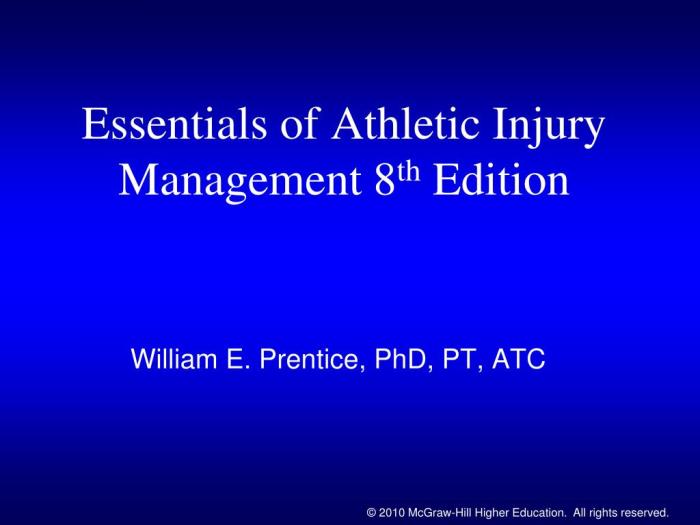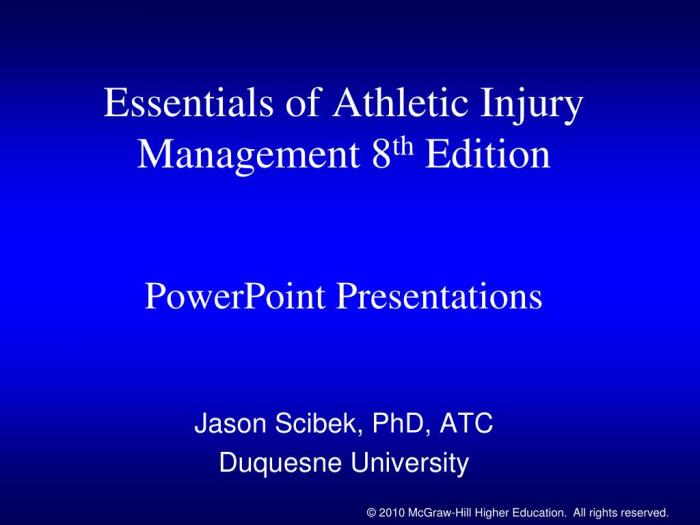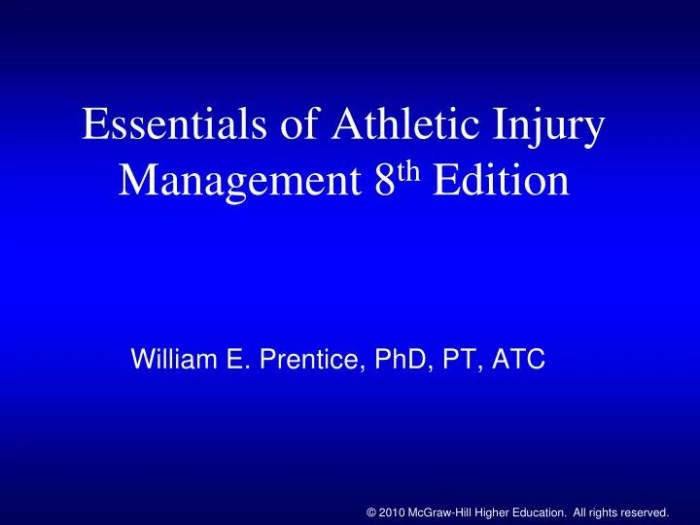Essentials of athletic injury management 12th edition – Essentials of Athletic Injury Management, 12th Edition sets the stage for this enthralling narrative, offering readers a glimpse into a story that is rich in detail and brimming with originality from the outset.
This comprehensive guide delves into the intricacies of athletic injury management, providing a thorough examination of the principles, assessment, treatment, and prevention of injuries in athletic populations. Written by a team of experts in the field, this book is an invaluable resource for healthcare professionals seeking to enhance their knowledge and skills in this critical area.
1. Introduction to Athletic Injury Management
Athletic injury management encompasses the prevention, assessment, diagnosis, treatment, and rehabilitation of injuries sustained during athletic activities. It is a critical aspect of sports medicine, ensuring that athletes can safely participate in their chosen sports and achieve optimal performance.
Healthcare professionals, including physicians, athletic trainers, and physical therapists, play a vital role in athletic injury management. They work together to provide comprehensive care, from injury prevention to post-rehabilitation follow-up.
2. Principles of Athletic Injury Management

The principles of athletic injury management provide a framework for effective injury care. These principles include:
- Timely intervention:Prompt assessment and treatment of injuries can minimize tissue damage and accelerate recovery.
- Accurate diagnosis:Correctly identifying the nature and extent of an injury is essential for appropriate treatment.
- Individualized treatment:Treatment plans should be tailored to the specific needs of each athlete, considering their injury, sport, and personal characteristics.
- Progressive rehabilitation:Rehabilitation programs should gradually increase intensity and complexity to restore function and prevent re-injury.
- Return to play:Athletes should be cleared for return to play only when they have regained full function and are at minimal risk of re-injury.
3. Assessment and Diagnosis of Athletic Injuries: Essentials Of Athletic Injury Management 12th Edition

Assessing and diagnosing athletic injuries involves a comprehensive evaluation of the athlete’s symptoms, medical history, and physical examination. Common assessment methods include:
- History-taking:Gathering information about the injury mechanism, pain characteristics, and past medical history.
- Physical examination:Inspecting and palpating the injured area, assessing range of motion, strength, and stability.
- Imaging studies:X-rays, MRI, or ultrasound may be used to visualize internal structures and confirm diagnoses.
4. Treatment and Rehabilitation of Athletic Injuries

Treatment and rehabilitation of athletic injuries aim to reduce pain, restore function, and prevent re-injury. Common treatment modalities include:
- Rest and immobilization:Limiting activity and providing support to the injured area can promote healing.
- Ice and compression:Cold therapy and compression can reduce inflammation and pain.
- Medications:Over-the-counter or prescription medications may be used to manage pain and inflammation.
- Physical therapy:Exercises and manual techniques aim to improve range of motion, strength, and flexibility.
- Surgery:In some cases, surgery may be necessary to repair damaged tissues or reconstruct structures.
Key Questions Answered
What are the key principles of athletic injury management?
The key principles of athletic injury management include early recognition and intervention, comprehensive assessment, individualized treatment plans, and a focus on rehabilitation and prevention.
How can athletic injuries be prevented?
Athletic injuries can be prevented by implementing strategies such as proper warm-up and cool-down routines, using appropriate equipment, and addressing risk factors such as muscle imbalances and poor biomechanics.
What is the role of healthcare professionals in athletic injury management?
Healthcare professionals play a crucial role in athletic injury management, providing assessment, diagnosis, treatment, and rehabilitation services. They work closely with athletes and coaches to develop individualized plans that optimize recovery and prevent future injuries.